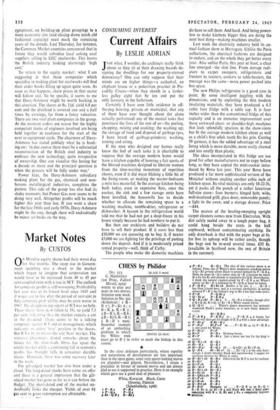Current Affairs
CONSUMING INTEREST By LESLIE ADRIAN JUST what, I wonder, do architects really think about as they sit at their drawing boards de- signing the dwellings for our property-starved democarcy? One can only suppose that their minds are on higher things—a cathedral, an elephant house or a pedestrian precinct in Pic- cadilly Circus—when they sketch in a larder- less galley eight feet by ten and put the only lavatory in the bathroom.
Certainly I have seen little evidence in off- the-peg housing, private or municipal, that any of them have ever thought about (let alone actually performed) any of the menial tasks that punctuate the lives of the rest of us—the peeling, chopping, mixing and cooking; the washing up; the storage of food and disposal of garbage (yes, I have heard of garbage-grinders); washing, ironing and airing.
If the men who designed our homes really knew the feel of such tasks it is charitable to suppose that the average modern home would have a kitchen capable of housing a fair quota of the blessed machines designed to liberate women from the time-wasting monotony of repetitive chores, even if it did mean filching a little bit of the living-room, or making the master-bedroom a mite less masterful. In the average kitchen being built today, even in expensive flats, once the cooker, the sink and a few storage units have been installed, the housewife has to decide whether to allocate the remaining space to a washing machine, tumble-drier, refrigerator or dishwasher. A tycoon in the refrigeration world told me that he had not got a deep-freeze in his house simply because he had nowhere to put it.
But then our architects and builders do not have to sell their product. If it costs less than £10,000 we are queueing up to buy it, if nearer £5,000 we are fighting for the privilege of putting down the deposit. And if it is moderately priced rented property—well, think of Cathy.
The people who make the domestic machines do have to sell them. And hard. And being power- less to make kitchens bigger they are doing the next best thing—making machines smaller.
Last week the electricity industry held its an- nual fashion show at Harrogate. Unlike the Paris collections, the electrical fashions are designed to endure, and on the whole they get better every year. Also unlike Paris, this year at least, a clear line emerged—the slim line. From storage radi- ators to carpet sweepers, refrigerators and freezers to toasters, cookers to table-heaters, the message was the same—more power packed into less space.
The new Philips refrigerator is a good case in point. By some intelligent juggling with the dimensions, and by exploiting the thin modern insulating materials, they have produced a 6.5 cubic foot fridge with a table top. It is four inches wider than the conventional fridge of this capacity and is an immense improvement over those awkward chest- or shoulder-high machines that look splendidly spacious in the show-rOom but fit the average modern kilchen about as well as a child's first adult tooth fits his grin. Costing 59 guineas, it has the added advantage of a steel lining which is more durable, more easily cleaned and less smelly than plastic.
The ideas incorporated in this fridge are too good for other manufacturers not to copy before long, as they have copied the mini-cooker intro- duced by Revo last year. This year Revo have produced a far more sophisticated version of the Minichef without stealing another cubic inch of kitchen space. Its vital statistics are only 18-22-36, yet it packs all the punch of a rather luxurious full-size stove: four burners; hinged hob; wide, well-insulated grill; glass door; removable panels; a light in the oven; and a storage drawer. Price —f 44.
The neatest of the beating-sweeping upright carpet cleaners comes new from Electrolux. With dirt safely sealed away in a tough paper bag, it could hang beside the coats in the hall cupboard, without contaminating anything. Its only drawback is that with the paper bags at 6s. for five its upkeep will be rather costly, though the bags can be re-used several times. £35 8s. (available in Scotland now, the rest of Britain in the summer).






























 Previous page
Previous page